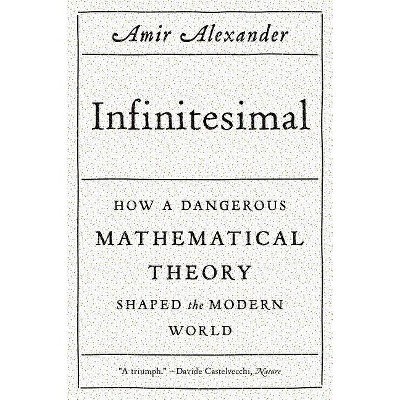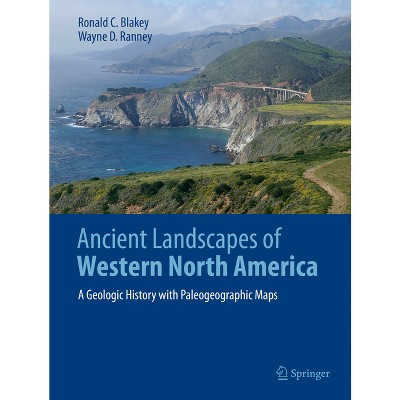Sponsored

Geometrical Landscapes - (Writing Science) by Amir R Alexander (Hardcover)
In Stock
Sponsored
About this item
Highlights
- This challenging book argues that a new way of speaking of mathematics and describing it emerged at the end of the sixteenth century.
- About the Author: Amir Alexander has taught history, philosophy, and the history of Science at Stanford University and the University of California, Los Angeles.
- 312 Pages
- Science, Earth Sciences
- Series Name: Writing Science
Description
About the Book
This challenging book argues that a new way of speaking of mathematics and describing it emerged at the end of the 16th century. Leading mathematicians began referring to their field in terms drawn from the exploration accounts of Columbus and Magellan. Many of those who promoted the vision of mathematics as heroic exploration also played central roles in developing the most important mathematical innovation of the period--the infinitesimal methods, which the author shows was no coincidence.Book Synopsis
This challenging book argues that a new way of speaking of mathematics and describing it emerged at the end of the sixteenth century. Leading mathematicians like Hariot, Stevin, Galileo, and Cavalieri began referring to their field in terms drawn from the exploration accounts of Columbus and Magellan. As enterprising explorers in search of treasures of knowledge, these mathematicians described themselves as sailing the treacherous seas of mathematics, facing shipwreck on the shoals of paradox, and seeking shelter and refuge on the shores of geometrical demonstrations. Mathematics, formerly praised for its logic, clarity, and inescapable truths, was for them a hazardous voyage in inhospitable geometrical lands.
Significantly, many of the same practitioners who promoted the vision of mathematics as heroic exploration also played central roles in developing the most important mathematical innovation of the period--the infinitesimal methods. This was no coincidence: the heroic tales of exploration and discovery helped shape a new form of mathematical practice, complete with new questions, new acceptable answers, and new standards of evidence. It was this new vision of mathematics as a grand adventure that allowed for the development of the new techniques that led to the Newtonian calculus.
In demonstrating this, the book moves from real voyages to imaginary ones, from the coasts of the Canadian Arctic to the tropical forests of Guyana, and from the inner structure of matter to the intricacies of the mathematical continuum. Throughout, a common rhetoric and imagery of exploration and discovery run like a thread through these diverse elements and bind them together.
From the Back Cover
This challenging book argues that a new way of speaking of mathematics and describing it emerged at the end of the sixteenth century. Leading mathematicians like Hariot, Stevin, Galileo, and Cavalieri began referring to their field in terms drawn from the exploration accounts of Columbus and Magellan. As enterprising explorers in search of treasures of knowledge, these mathematicians described themselves as sailing the treacherous seas of mathematics, facing shipwreck on the shoals of paradox, and seeking shelter and refuge on the shores of geometrical demonstrations. Mathematics, formerly praised for its logic, clarity, and inescapable truths, was for them a hazardous voyage in inhospitable geometrical lands.Significantly, many of the same practitioners who promoted the vision of mathematics as heroic exploration also played central roles in developing the most important mathematical innovation of the period--the infinitesimal methods. This was no coincidence: the heroic tales of exploration and discovery helped shape a new form of mathematical practice, complete with new questions, new acceptable answers, and new standards of evidence. It was this new vision of mathematics as a grand adventure that allowed for the development of the new techniques that led to the Newtonian calculus.
In demonstrating this, the book moves from real voyages to imaginary ones, from the coasts of the Canadian Arctic to the tropical forests of Guyana, and from the inner structure of matter to the intricacies of the mathematical continuum. Throughout, a common rhetoric and imagery of exploration and discovery run like a thread through these diverse elements and bind them together.
Review Quotes
"A short review cannot do justice to this exceptional, seminal work. Through meticulous interpretation of the writings of mainly English authors from the age of discovery, Alexander develops a new and illuminating perspective on the maritime, mathematical, and scientific explorations of that age...An invaluable work."--CHOICE
"This is one of the most important books to appear in the history of early modern science. Moving into an uncharted field, namely mathematics and the turn toward infinitesimals, Alexander develops a controversial argument--and that is a tribute to its originality. This is a work of singular importance that will be discussed for years to come."--Margaret C. Jacob, University of California, Los Angeles
About the Author
Amir Alexander has taught history, philosophy, and the history of Science at Stanford University and the University of California, Los Angeles.










